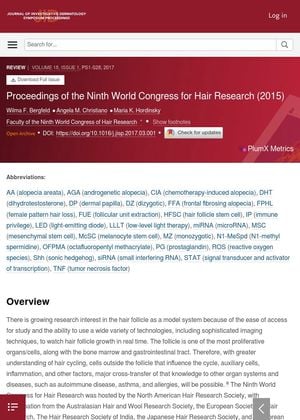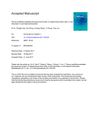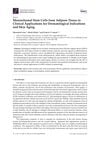Proceedings of the Ninth World Congress for Hair Research 2015
January 2017
in “
Journal of Investigative Dermatology Symposium Proceedings
”
mesenchymal stem cells maraviroc simvastatin Alopecia Areata topical minoxidil finasteride intralesional steroids Frontal Fibrosing Alopecia PTGDR2 antagonists low-level light therapy robotic device for follicular unit extraction nutrition hair follicle cycling personalized medicine Rogaine Propecia LLLT FUE

TLDR The 2015 Hair Research Congress concluded that stem cells, maraviroc, and simvastatin could potentially treat Alopecia Areata, topical minoxidil, finasteride, and steroids could treat Frontal Fibrosing Alopecia, and PTGDR2 antagonists could also treat alopecia. They also found that low-level light therapy could help with hair loss, a robotic device could assist in hair extraction, and nutrition could aid hair growth. They suggested that Alopecia Areata is an inflammatory disorder, not a single disease, indicating a need for personalized treatments.
The Ninth World Congress for Hair Research in 2015, attended by over 700 professionals, focused on hair growth, hair and scalp disease, and clinical care. Various studies and discussions were presented on hair disorders, alopecia, hair transplantation techniques, and hair loss treatments. Key findings included the potential of mesenchymal stem cells, maraviroc, and simvastatin as treatments for Alopecia Areata (AA), the effectiveness of topical minoxidil, finasteride, and intralesional steroids in treating Frontal Fibrosing Alopecia (FFA), and the potential of PTGDR2 antagonists as a treatment for alopecia. The congress also highlighted the potential of low-level light therapy for hair loss, the benefits of a robotic device for follicular unit extraction, and the potential of nutrition in hair growth. The congress concluded with the suggestion that Alopecia Areata is an inflammatory disorder of hair follicle cycling rather than a single disease, indicating a need for personalized medicine in future AA management.

